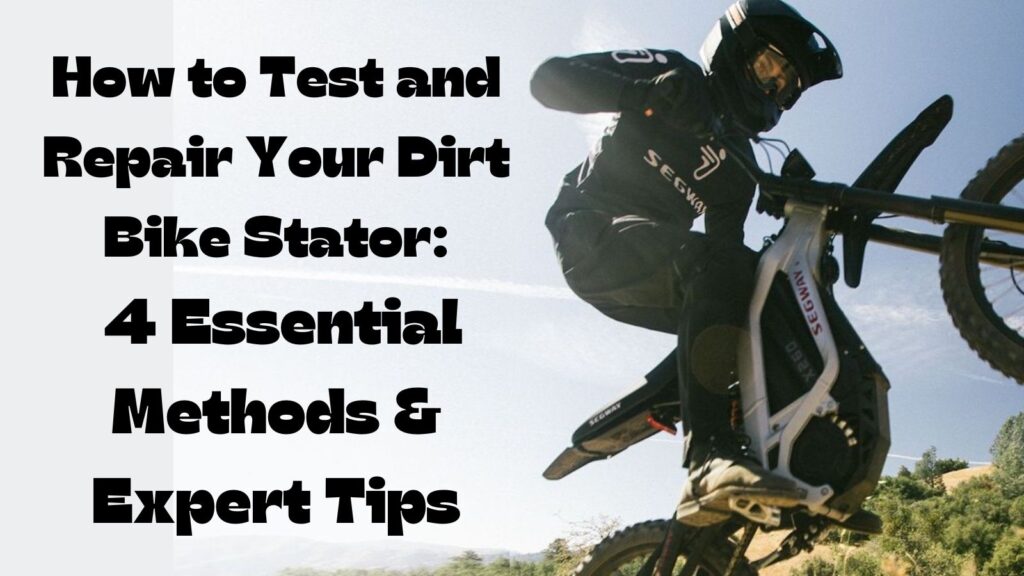A dirt bike’s stator is a crucial component responsible for generating the electricity required to power the spark plug and other electrical systems. If your stator begins to fail, it can lead to a series of performance issues, making it essential to know how to test it and identify problems early. Whether you’re dealing with starting issues, weak sparks, or backfiring, testing your stator is a practical way to diagnose electrical problems.

In this article, we will cover the four primary methods of testing a dirt bike stator, explore common causes of stator failure, and provide guidance on repairing or replacing the stator. With the help of this guide, you’ll be able to troubleshoot and maintain your bike’s electrical system like a pro.
1. Understanding the Importance of Your Dirt Bike Stator
The stator is a critical part of your dirt bike’s electrical system. It works alongside the flywheel to generate electricity. When the engine is running, the stator uses magnetic fields to create alternating current (AC) voltage that powers the ignition system, lights, and other electrical components. Without a functioning stator, your bike would fail to produce the necessary spark to start or maintain running, and your electrical systems would cease to operate.
2. Signs Your Dirt Bike Stator Needs Attention
Before diving into testing, it’s essential to recognize the symptoms of a faulty stator. These signs typically include:
- Hard Starting: Difficulty starting your bike, especially when the engine doesn’t seem to fire properly.
- Weak or No Spark: A weak spark from the spark plug or no spark at all can indicate a stator problem.
- Misfiring: Random misfiring while riding, especially at higher RPMs, is often caused by a malfunctioning stator.
- Backfiring: A stator failure can also cause backfiring, although this issue may have other underlying causes.
- Battery Issues: If your stator isn’t generating enough power, your bike may experience battery-related issues.
If you experience any of these problems, it’s time to test your stator and potentially replace it.
3. How to Test a Dirt Bike Stator
Testing your stator can be done through several methods. The most common are dynamic testing, static testing, voltage testing, and visual inspection. Here’s a breakdown of each method:
Method 1: Dynamic Testing
Dynamic testing involves checking the AC voltage between phases while the engine is running. This method gives you a good indication of whether the stator is functioning as it should.
Steps for Dynamic Testing:
- Set your multimeter to measure AC voltage.
- Start the engine and measure between the three terminals (Phase 1 & 2, Phase 2 & 3, Phase 3 & 1).
- A healthy stator will show positive readings on all three terminals, and the readings will increase with RPMs.
- If the readings do not increase or remain the same across all terminals, the stator is likely faulty and needs replacement.
Method 2: Static Testing
Static testing helps identify problems with coil resistance and is done with the engine off.
Steps for Static Testing:
- Set your multimeter to the ohms (resistance) setting.
- Measure the resistance between coils (Phase 1 & 2, Phase 2 & 3, Phase 3 & 1).
- For most dirt bikes, the resistance should fall between 0.1 to 1 ohm. Higher resistance readings indicate a faulty stator.
- Check the multimeter reading from each terminal to ground. It should read OL (open loop) if the stator is functioning correctly. If it reads 0, the circuit is closed, and the stator may be defective.
Method 3: Voltage Testing
Voltage testing ensures that your battery is supplying the correct amount of power to the stator.
Steps for Voltage Testing:
- Set your multimeter to measure DC voltage.
- Measure the voltage across the battery terminals.
- If the voltage is below 12.5V, your battery may be undercharged, which can cause stator malfunction. Charging your battery should resolve this issue.
- Inspect the battery cables, terminals, and the ground connection for any signs of corrosion or damage.
Method 4: Visual and Phenomenal Testing
Sometimes, the best way to test a stator is to physically inspect it for signs of damage. A visual inspection can reveal issues like:
- Burnt or Disconnected Wires: Check for signs of burnt coils or disconnected wires that may prevent the stator from functioning properly.
- Cracks or Damage: Look for cracks in the stator housing or other visible damage that might affect performance.
- Thermal Damage: If the stator shows signs of excessive heat (discoloration or melting), it’s likely that it has been subjected to overload or overheating.
4. Common Causes of Stator Failure
Several factors can contribute to a stator failure. Understanding these causes can help prevent issues and prolong the life of your stator:
- Overloading: Using too many electrical accessories (e.g., lights, GPS, heated grips) at once can strain the stator.
- Old Age: Over time, wear and tear from vibrations, heat, and environmental exposure can degrade the stator.
- Accidents: A major accident can damage the stator, causing it to malfunction.
- Poor Maintenance: Failing to clean or inspect the stator regularly can lead to performance issues, like poor coil insulation or debris buildup.
5. How to Repair a Dirt Bike Stator
Repairing a stator can be a complex process, but with the right tools and knowledge, it is possible to repair rather than replace it. Follow these steps:
Step 1: Remove the Stator
To begin, you must remove the stator from the engine. This typically requires removing the flywheel or other components to gain access to the stator.
Step 2: Inspect for Damage
Once removed, visually inspect the stator for signs of wear or thermal damage. If the stator’s windings are burnt or disconnected, they may need to be repaired or replaced.
Step 3: Rewind the Stator
If the windings are damaged, you may need to rewind the stator. Carefully remove the old wire and replace it with fresh wire. Ensure the wire is wound tightly and evenly around the stator core.
Step 4: Insulate the Coils
Once the rewinding process is complete, apply insulating varnish to protect the coils from future damage.
Step 5: Reassemble and Test
After reassembling the stator, reinstall it in your bike and conduct a series of tests (as mentioned earlier) to ensure it’s functioning correctly.
MUST READ:
20 Reasons Why Your Dirt Bike Is Not Starting (Explained) – AuttoMotoGeek
Why Is My Motorcycle Buzzing When I Try To Start It – AuttoMotoGeek
6. 5 Frequently Asked Questions (FAQs)
Q1: How do I know if my dirt bike stator is bad?
If your bike experiences difficulty starting, weak spark, misfiring, backfiring, or battery issues, it could be a sign that your stator is malfunctioning. Testing with a multimeter can confirm if the stator is the issue.
Q2: Can I ride with a bad stator?
It’s not advisable to ride with a bad stator, as it will affect your bike’s ability to start, run, and maintain electrical functions. Continuing to ride with a faulty stator can cause further damage to your bike.
Q3: How long does a dirt bike stator last?
A stator’s lifespan depends on usage, maintenance, and external factors like heat and vibrations. Generally, stators can last anywhere from 5 to 10 years but may need replacing sooner if overused or damaged.
Q4: Can I replace the stator myself?
Yes, replacing a stator is a DIY job if you have the right tools and knowledge. However, it can be challenging, so make sure to follow a detailed guide and consult a mechanic if you’re unsure.
Q5: What is the cost of replacing a stator?
The cost of replacing a stator varies depending on the bike model and brand. On average, expect to pay between $300 to $1500 for a new stator, including labor costs if you’re not performing the replacement yourself.
7. Conclusion
Testing and repairing a dirt bike stator can seem like a daunting task, but with the right tools and knowledge, it becomes a manageable job. Regularly testing your stator, performing proper maintenance, and addressing issues early can prevent costly repairs and keep your bike running smoothly. If you’re unsure about any aspect of testing or repairing your stator, don’t hesitate to consult a professional mechanic to ensure the job is done right.
Final Notes: With this expanded guide, you now have a comprehensive understanding of how to test, diagnose, and repair your dirt bike stator. Regular maintenance and quick action when issues arise will keep your bike’s electrical system functioning and extend the life of your stator. Happy riding!





